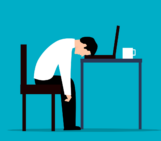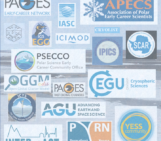
The pleasures of a polar summer meditation after a long fieldwork day at Zackenberg, NE Greenland. [Credit: Maria Scheel]
We often start searching for the term “mental health” online only when mental issues are already arising. It seems to be a trendy word on everyone’s social media. Of course, you don’t have to suffer already in order to learn about, and benefit from, mindfulness – or the ability to notice the present moment and what is going on in your life. In this post, I am sharing how I became a more mindful scientist, and why I am convinced that anyone can benefit personally and professionally from learning about and starting to practice a little bit more mindfulness.
A personal experience
Maybe surprisingly, my journey towards mindfulness started with science. During my Biochemistry undergraduate studies, I suddenly started having panic attacks (maybe I’ll blame organic chemistry for that). These are random flight-fight-freeze responses by the brain chemistry. Back then, luckily, someone recommended that I try a mindful breathing meditation. To be honest, it did not work right away, as focusing on negative body sensations was easier than focusing on my breath (we all know how much old habits can stick). However, after a while, I could observe, from what felt like a bird’s eye perspective, whatever body sensations or thoughts arose. Now, 7 years later, I enjoy meditation as part of my daily routine.
With the global lockdown, we spent much more time with ourselves without luxurious distractions. Many people discovered formerly ignored pains and issues. The recent lockdown also hit me with the realization that I actually felt burnt out after spending most of my home office with no perceived achievement and blaming myself for the delays. In order to become aware of the root of the problem, I decided to take some time off for a reality check: Where did my energy go and which sources were missing?
What is mindfulness?
Both my meditation practice and the reality check to uncover what was boiling under the surface were forms of mindful practices. And yes, they are actions, a training even, not one-time achievements. Everyone talks about this mysterious mindfulness but still it seems so vague. What is it then? Jon Kabat-Zinn, a globally recognized mindfulness teacher and my first gateway to the topic, defines mindfulness as:
Paying attention in a particular way: on purpose, in the present moment, and nonjudgmentally.”
This means a) it is about what matters to you right now, b) you do not judge your experience (which I also see as having a kind attitude), and c) you choose to do this consciously.
As an example: You set your daily goals, but you are tired and end up not achieving one of them. All evening you are pondering on would-a-could-a-should-a’s, and then decide to work even harder the next day. This is fueling yourself with a negative motivation. But what if you sat down, became aware of “it feels bad (e.g. to have missed this goal)”, and gave yourself a compassionate “that is okay”, without justifying? Knowing that you are at peace with yourself will be the best basis for restarting the next morning. It sounds counterintuitive, but I tried it several times and ended up more productive and happy than ever before.

Journaling all ongoing thoughts down can be a great way become mindful of what is going on under the surface [Credit: Lisa Fotios, Pexels]
Well, how to do the magic then? In a way, it is not about what exercise you do, but how you do things in your life. Still, here are some of the tools I found useful throughout the last years, which are now part of my practice. These are only recommendations for you to playfully test and find which options work for you. Keep in mind that many of these recommendations, like any good routine, need time to develop and deepen. Start small — for example with 5 minutes 3 times a week — and watch what it does to you. It is okay to start small in order to see successes.
- To counteract the feeling of falling short in my remote work, I began by writing down 3 daily goals every morning, no matter if private or work-related. This taught me what an achievable goal is and how much time I can dedicate per day. I also end each workday with noticing all successes, no matter how small they are. Every little step matters. I sort them into “actions” and “lessons learned” and include which characteristics and strengths helped me achieve them. This helped me develop a realistic picture of myself, letting go more of my former imposter and perfectionist tendencies.
- Yoga can also improve your feeling for mindfulness, as the movements are linked to your breath. How often are we aware of breathing in and out and how deep or shallow the breath is? Apart from regular, longer practices each week, my home office became much more physically appealing when I added lunch and after-work yoga stretches . Of course, any physical practice can help to balance too much mental activity and with that bring calm to cycling negative thoughts.
- While these work well in solitude, the pandemic made us especially aware of how being connected to our community is important for healing. No matter if virtual or in person, we are not on this planet alone and socializing often made me aware of this. Right now might be the best time to reflect on which people you miss most, what value they add to your live, and actually let them know.
- The last point leads onto expressing gratitude to your loved ones. This is one of our most underestimated energy sources. We habitually find problems and solutions, especially in critical-rational minded Academia. Gratitude means finding value and thankfulness for what we already have in our lives, rather than scanning for what is still missing. Every day, I try to find three things that really made me feel joy, such as an inspiring feedback after a presentation or a perfect cat meme.
- Meditation is a great tool to train that mental muscle of focus and decrease the pressure of chaotic thoughts and feelings. You simply find a calm space to sit for some time, close your eyes and be Focusing on one meditation object, which can be a guided mediation to start with, your breath, sounds around you or your body sensations, eventually trains your awareness. Nowadays, many apps supply meditations and daily reminders, such as headspace, insight timer, and calm. Also, everyday activities such as washing dishes and taking a walk are mindful, when done with awareness and curiousity. “How does this feel?” Thich Nhat Hanh is a renowned Zen and mindfulness teacher and shares great resources on how to start bringing mindfulness into everyday life.
- When a negative emotion needs attention, I found a lot of guidance in Tara Brach’s talks and can highly recommend the RAIN practice. This means you recognize an issue in your life, accept it, investigate its roots and try to nurture this painful spot. When it is hard to find the needle in the haystack of your thoughts, it often helps to write your thoughts out on paper (also called journaling) until you feel you found the root of what might have caused discomfort earlier.
The benefits of mindfulness
What happened after my time off and reality check? I could finally focus on redefining my PhD motivation (which counteracts procrastination), tap into my long-term career aspiration and find a daily rhythm that works for me. I relearned setting realistic goals, focusing, and reflecting shortcomings in order to improve my methodology. This decreased my level of stress significantly and helped me to focus on and prioritize my research interests and projects according to the energy and time I really have.
Overall, my meditation practice alone rewarded me with a higher sense of calm, control (because of being aware) of what is going on in my life, more stability in response to stressors. Yoga also kept my body fit with all the academic sitting (outside of fieldwork) and journaling allows me to practice my 5 year-old’s hand writing. By now, I am proud of how much I learned and have grown in the process, both personally and professionally. Exactly this achievement makes me hopeful that more people can find this peace and empowerment in Academia and foster a kinder environment.

One of my greatest ways to become more content and productive in workdays are daily long walks [Credit: Yogendra Singh, Pexels]
Bringing awareness to your work space
This kind and patient alternative to judgment and guilt can be applied in all aspects of life, so why not also in science? Even Nature published recently about how mindfulness helps us to be happier and better at work. Early career researchers in Academia particularly experience a decrease of their mental health. Some of the many triggers include the high levels of expectation, comparison and feelings of insufficiency. The New York Times sums up the many tools helping to implement mindfulness and kindness in work environment. You can also try the “Mindfulness at Work 40-day challenge” with daily 10-minute reflections and meditations by Tara Brach and Jack Kornfield. In case you find yourself working from home, now might be a great time to experiment adding mindfulness practices into your daily work rhythm.
Mindfulness at EGU
At EGU, a blog series called “Mind Your Head” explores topics related to mental health, e.g. anxiety and a good routine when working at home. During the first virtual general assembly in 2020, a webinar also tackled this topic and is now available on Youtube. It was a great teaser for what to expect when attending this year’s #vEGU21 “Mind Your Head” session, with many more insights to come.
Further reading
- More in depth explanation about the concepts mentioned and particular application in everyday academic work can explored in this great publication: Wells, C. M. (2013). Mindfulness in Academia: Considerations for Administrative Preparation. Education Leadership Review, v14 n3 p1-11.
- Some studies evaluated the benefits of mindfulness in the context of scientific work already: Hyland, P., Lee, R., & Mills, M. (2015). Mindfulness at Work: A New Approach to Improving Individual and Organizational Performance. Industrial and Organizational Psychology, 8(4), 576-602. doi:10.1017/iop.2015.41
Edited by Francesco Avanzi and Jenny Turton
 Maria Scheel is a PhD student at Aarhus University in Denmark, where she works tightly linked with the Greenland Ecosystem Monitoring and the Arctic Research Centre. Despite Marine Biologist by education, her passion for genetics brought her to the terrestrial realm, where her research explores how Arctic permafrost microbes adapt to the ongoing erosion and changing climate. Besides that, she is part of the national committee for APECS Denmark. She recently started her blog Mindful Scientist, sharing experiences and raising awareness about a healthy mind at work as well as breaking some scientist stereotypes.
Maria Scheel is a PhD student at Aarhus University in Denmark, where she works tightly linked with the Greenland Ecosystem Monitoring and the Arctic Research Centre. Despite Marine Biologist by education, her passion for genetics brought her to the terrestrial realm, where her research explores how Arctic permafrost microbes adapt to the ongoing erosion and changing climate. Besides that, she is part of the national committee for APECS Denmark. She recently started her blog Mindful Scientist, sharing experiences and raising awareness about a healthy mind at work as well as breaking some scientist stereotypes.




